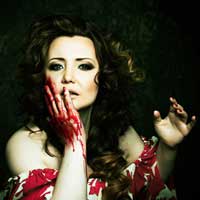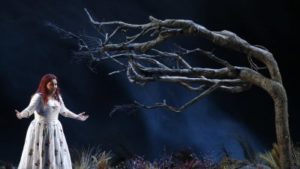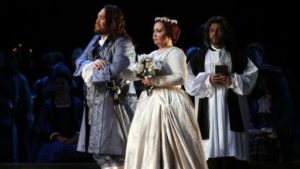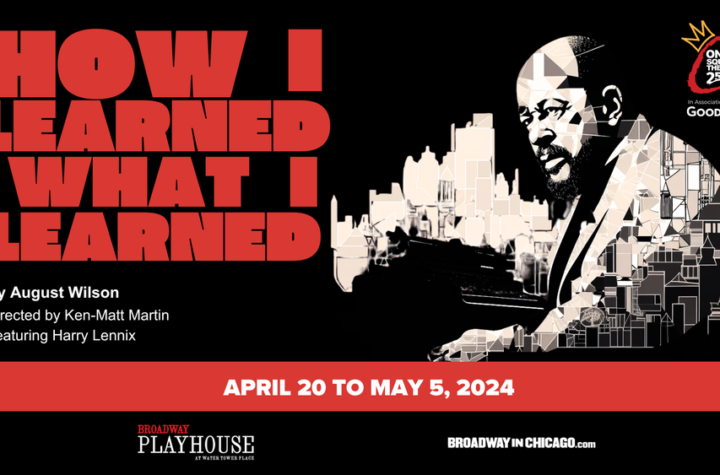
 [rating=3]This season the Lyric Opera of Chicago will be presenting Gaetano Donizetti’s Lucia di Lammermoor and Vincenzo Bellini’s Norma, two of the most famous examples of bel canto music, an early nineteenth century Italian genre which featured frequent coloratura-infused variations. The production of Lucia di Lammermoor, now running through November, includes some of the best of the outstanding talent the Lyric attracts, including soprano Albina Shagimuratova in the title role and conductor Enrique Mazzola in his Lyric debut, performing a renowned score. The Lyric is also using this season to show off their new scenic technology, which may be seen in their original productions of Richard Wagner’s Ring Cycle and Hector Berlioz’s Les Troyens. However, Graham Vick’s production of Lucia di Lammermoor premiered twenty years ago, and its run here is a stark reminder of how much scenic technology has changed. The music is a true treat to listen to, and when Vick’s vision works, it works well, but the staging is not always ideal.
[rating=3]This season the Lyric Opera of Chicago will be presenting Gaetano Donizetti’s Lucia di Lammermoor and Vincenzo Bellini’s Norma, two of the most famous examples of bel canto music, an early nineteenth century Italian genre which featured frequent coloratura-infused variations. The production of Lucia di Lammermoor, now running through November, includes some of the best of the outstanding talent the Lyric attracts, including soprano Albina Shagimuratova in the title role and conductor Enrique Mazzola in his Lyric debut, performing a renowned score. The Lyric is also using this season to show off their new scenic technology, which may be seen in their original productions of Richard Wagner’s Ring Cycle and Hector Berlioz’s Les Troyens. However, Graham Vick’s production of Lucia di Lammermoor premiered twenty years ago, and its run here is a stark reminder of how much scenic technology has changed. The music is a true treat to listen to, and when Vick’s vision works, it works well, but the staging is not always ideal.
The main themes of the libretto, by Salvatore Cammarano and based on the novel The Bride of Lammermoor by Sir Walter Scott, are psychological abuse and the extreme, erratic emotions brought on by violence. Donizetti’s music is a study in incongruity, with jaunty violins and flutes often being used for moments when characters are in crises. An early example of this is heard in the aria “Cruda, funesta smania,” sung by Enrico Ashton (Quinn Kelsey) when he learns from his sneering captain, Normanno (Matthew DiBattista), that his sister, Lucia, is having an affair with the Ashtons’ nemesis, Sir Edgardo (Piotr Beczala). Enrico describes himself as being in a frenzy over his sister’s betrayal—not in the least because he was depending on an arranged marriage between her and one of his friends to secure his political position—yet the music remains upbeat, and the audience has only the supertitles and the Kelsey’s brooding acting to know that Enrico his vowing to drench his sister with blood and hoping she gets struck by lightning.
Lucia herself appears in the second scene, pining for Edgardo alongside her friend, Alisa (Lindsay Metzger), and it is here that Vick’s staging starts to become an issue. In her aria “Regnava nel silenzio” Lucia describes seeing a murder victim’s ghost beckoning to her, and then claims that Edgardo’s affection is her only solace. The aria is over eight minutes long due to its repetitions, and Vick elected to utilize a park-and-bark style of delivery for most of the key play’s moments. This works well in later scenes, when the characters are becoming more detached from reality and losing control of events, but in this scene, he has Alisa become annoyed with the length of Lucia’s solo, fidget with a prop, and stop paying attention to what Lucia is saying. Making the music itself the joke before the production has demonstrated its own merits is unwise, particularly as Shagimuratova is a marvelous singer with fantastic volume control, and listening to her complicated variations is in no way boring.
Edgardo, it turns out, is a quite morbid young man, though Beczala lends gravitas to the tenor role. Before the end of the second act, Enrico tricks Lucia into renouncing Edgardo in favor of Lord Arturo Bucklaw (Jonathan Johnson), another character Enrico deceives, and to make sure we are to understand we should not like him, Johnson has been instructed to keep his arms in an absurd swan-like posture. Adrian Sampetrean, as the sober old priest Raimondo Bidebent, completes the famous sextet “Chi mi frena in tal momento,” which Mazzola smoothly leads the Lyric’s orchestra through with great skill which demonstrates the brilliance of Donizetti’s unnerving score. Michael Black also deserves credit for leading the chorus, whose reprimand of Edgardo in this scene is something of a turning point for this production as far as the effectiveness of Vick’s vision goes.
In the third act, following an intermission, the constantly-shifting backdrops finally earn their place. Blank, black walls enclose the characters, in a visual effect reminiscent of tunnel vision, and the low lighting makes the scrubland look desolate. Sampetrean’s aria “Dalle stanze ove Lucia” is eerie, yet melodious, as if he were in the same kind of trance he is describing seeing Lucia in, and Sampetrean knows how to channel the glow of the footlights. In the long-awaited musical climax, “Il dolce suono” the set and lighting rise to Shagimuratova’s level, creating an arresting image which matches the now-surreal music, but it helps that this is also the only aria in which Shagimuratova is allowed to move around. Vick also had the good idea of changing the manner of Lucia’s death—in the original, she dropped dead from having too many emotions, but here, her suicide is horrific. Beczala’s heart-rending and wonderfully articulate “Tu che a Dio spiegasti l’ali” is an ideal ending to the opera, in which Donizetti one last time combines incongruent sounds to represent the grip of madness. Musically, this Lucia di Lammermoor is a triumph. As a production, it works about half the time. But because the half when it is outstanding is mostly in the latter part, I predict most audience members will leave with a favorable impression.
The Lyric Opera’s Lucia di Lammermoor will run at the Civic Opera House, 20 N Wacker Drive, Chicago, thru November 6. Running time is three hours, with one intermission. Performances are as follows:
 Wednesday, October 19 at 7:30 pm
Wednesday, October 19 at 7:30 pm
Sunday, October 23 at 2:00 pm
Wednesday, October 26 at 7:30 pm
Saturday, October 29 at 7:30 pm
Tuesday, November 1 at 7:30 pm
Sunday, November 6 at 7:30 pm
Tickets are $34-299 and can be purchased by calling 312-332-2244 or visiting LyricOpera.org.
To see what others are saying, visit www.theatreinchicago.com, go to Review Round-Up and click at “Lucia di Lammermoor.”






More Stories
“How I Learned What I Learned” reviewed by Julia W. Rath
“How to Know the Wild Flowers: A Map” reviewed by Julia W. Rath
“Baby: the Musical”